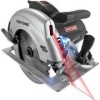Craftsman 7-1/4 Operation Manual - Page 17
Ways to Help Prevent Kickback - inch saw blade
 |
View all Craftsman 7-1/4 manuals
Add to My Manuals
Save this manual to your list of manuals |
Page 17 highlights
Ways to Help Prevent Kickback ALWAYS release trigger switch immediately if the blade binds or the saw stalls. Kickback could cause you to lose control of the saw. Loss of control can lead to serious injury. ALWAYS maintain a firm grip with both (see Fig 6) hands on the saw and position your body and arms to allow you to resist Kickback forces_ Kickback forces can be controlled by the operator, if the proper precautions are taken. ,, If the blade is binding, or when you are interruptinga cut for any reason, ALWAYS release the trigger and hold the saw motionless in the material until the blade comes to a complete stop° NEVER attempt to remove the saw from the work or pull the saw backward while the blade is in motion, or Kickback may occur CHECK and take corrective action to eliminate the cause of blade binding. 3, Inspect the workpiece for knots or nails before cutting. Never saw into a knot or nail, 4. DO NOT cut warped or wet lumber (see Fig 5a), 5, ALWAYS support large panels to minimize the risk of blade pinching and Kickback. Large panels tend to sag under their own weight(see Fig, 5a) Supports MUST be placed under the panel, one near the line of cut and one near the edge of the panel (see Fig. 5). 6, When restarting the saw in the workpiece, CENTER the blade in the kerr and check to be sure that the saw teeth are not engaged into the material, If the saw blade is binding, it may walk up or Kickback from the workpiece when the saw is restarted. 7, DO NOT use a dull or damaged blade Unsharpened, improperly set, or gummed-up blades produce narrow kerr which causes excessive friction, blade binding and Kickback_ 8, KEEP the blade at the correct depth setting. The depth setting should not exceed 1/4*inch below the material being cut (see Fig, 4). BE SURE that the blade depth and adjusting locking levers are tight and secure BEFORE making a cut, If blade adjustment shifts while cutting it may cause binding and Kickback, 9, USE EXTRA CAUTION when making a "Pocket Cut" into existing walls or other blind areas. The protruding blade may cut objecls that can cause Kickback 17 -J















